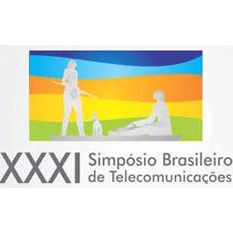
XXXI Simpósio Brasileiro de Telecomunicações

WiFi Multifloor Indoor DCM Positioning
Rafael Saraiva Campos, Lisandro Lovisolo, Marcello L. R. de Campos
DOI: 10.14209/sbrt.2013.109
Keywords: Mobile Stations WiFi Networks Indoor Positioning Radio-frequency Fingerprint Kohonen Layer Backpropagation.
Abstract
Database correlation methods (DCM) are used to locate mobile stations (MS’s) in wireless networks. A target radiofrequency (RF) fingerprint - measured by the MS to be localized - is compared with georeferenced RF fingerprints, previously stored in a correlation database (CDB). This paper focuses on the DCM positioning in multifloor indoor environments. In this scenario, the authors apply two combined techniques to reduce the search space inside the CDB, while improving the floor identification accuracy: i) unsupervised clustering using a single Kohonen Layer and ii) floor classification using committees of backpropagation artificial neural networks (ANN’s), one committee per each floor. The effects of the proposed solution on the DCM positioning accuracy are experimentally evaluated using 46200 target fingerprints and a CDB with 924 reference fingerprints, containing Received Signal Strength (RSS) values of 136 WiFi 802.11b/g networks in a 12-floor building. The correct floor is identified in 91% of the samples, and is within 2 floors in 99% of the samples. The average positioning error is 4.7 meters and is below 5.5 meters in 75% of the samples.Download
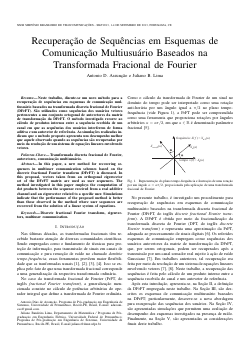
Recuperação de Sequências em Esquemas de Comunicação Multiusuário Baseados na Transformada Fracional de Fourier
Antonio D. Assunção, Juliano B. Lima
DOI: 10.14209/sbrt.2013.248
Keywords: Transformada discreta fracional de Fourier autovetores comunicação multiusuário.
Abstract
Neste trabalho, discute-se um novo método para a recuperação de sequências em esquemas de comunicação multiusuário baseados na transformada discreta fracional de Fourier (DFrFT). São utilizados como sequências dos usuários vetores pertencentes a um conjunto ortogonal de autovetores da matriz de transformação da DFrFT. O método investigado recorre ao cálculo de produtos internos entre a sequência recebida de um canal em que as sequências dos usuários interferem de forma aditiva e um autovetor de referência. As simulações realizadas indicam que o método proposto apresenta um desempenho melhor que aquele observado quando as sequências são recuperadas por meio da resolução de um sistema de equações lineares envolvendo vetores.Download
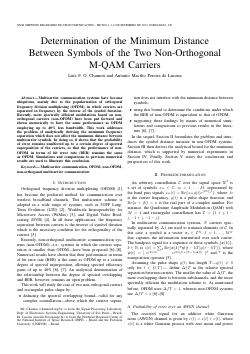
Determination of the Minimum Distance Between Symbols of the Two Non-Orthogonal M-QAM Carriers
Luiz F. O. Chamon, Antonio Macilio Pereira de Lucena
DOI: 10.14209/sbrt.2013.111
Keywords: Mutlicarrier communication OFDM non-OFDM non-orthogonal multicarrier communication
Abstract
Multicarrier communication systems have become ubiquitous, mainly due to the popularization of orthogonal frequency division multiplexing (OFDM), in which carriers are separated in frequency by the inverse of the symbol duration. Recently, more spectrally efficient modulations based on non- orthogonal carriers (non-OFDM) have been put forward and shown numerically to have the same performance as OFDM employing up to 40% less bandwidth. This work addresses the problem of analytically deriving the minimum frequency separation which does not affect the minimum distance between multicarrier symbols. In doing so, it shows that the probability of error remains unaffected up to a certain degree of spectral superposition of the carriers, so that the performance of non- OFDM in terms of bit error rate (BER) remains the same as OFDM. Simulations and comparisons to previous numerical results are used to illustrate this conclusion.Download
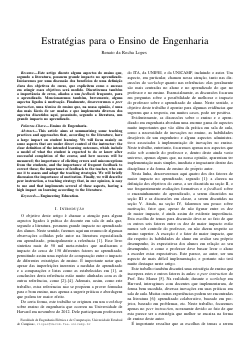
Estrategias para o Ensino de Engenharia
Renato da Rocha Lopes
DOI: 10.14209/sbrt.2013.112
Keywords: Ensino de Engenharia
Abstract
Este artigo discute alguns aspectos do ensino que, segundo a literatura, possuem grande impacto no aprendizado. Iniciaremos por uma discussão dos benefícios de uma definição clara dos objetivos do curso, que explicitem como o sucesso em atingir esses objetivos será medido. Discutiremos também a importância de erros, aliados a um feedback frequente, para o aprendizado. Mencionaremos também, brevemente, alguns aspectos ligados a motivação. Finalmente, descreveremos o peer instruction, uma técnica de ensino que, na nossa opinião, é uma das mais fáceis de ser usadas e que implementa diversos dos aspectos discutidos aqui, possuindo, segundo a literatura, um grande impacto no aprendizado.Download
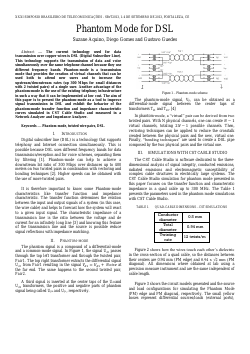
Phantom Mode for DSL
Suzane Aquino, Diego Gomes, Gustavo Guedes
DOI: 10.14209/sbrt.2013.110
Keywords: Phantom-mode twisted wire pairs DSL.
Abstract
The current technology used for data transmission over copper wires is DSL (Digital Subscriber Line). This technology supports the transmission of data and voice simultaneously over the same telephone channel because they use different frequency bands. Phantom-mode is a transmission mode that provides the creation of virtual channels that can be used both to attend new users and to increase the upstream/downstream rates (up 300 Mbps for small distances with 2 twisted pairs) of a single user. Another advantage of the phantom-mode is the use of the existing telephony infrastructure in such a way that it can be implemented at low cost. The aim of this paper is to present the phantom-mode as a tool to improve signal transmission in DSL and exhibit the behavior of the phantom-mode transfer function and impedance characteristic curves simulated in CST Cable Studio and measured in a Network Analyzer and Impedance Analyzer.Download
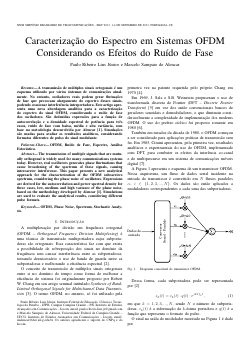
Caracterização do Espectro em Sistemas OFDM Considerando os Efeitos do Ruído de Fase
Paulo Ribeiro Lins Júnior, Marcelo Sampaio de Alencar
DOI: 10.14209/sbrt.2013.115
Keywords: OFDM Ruído de Fase Espectro Análise Estocástica
Abstract
A transmissão de múltiplos sinais ortogonais é um esquema utilizado por vários sistemas de comunicações atualmente. No entanto, osciladores reais podem gerar flutuações de fase que provocam alargamento do espectro desses sinais, podendo ocasionar interferência interportadora. Este artigo apresenta uma nova abordagem analítica para a caracterização do espectro do sinal OFDM, considerando o ruído de fase dos osciladores. São deduzidas expressões para a função de autocorrelação e a densidade espectral de potência para três casos, ruído de fase com baixa, média e alta variância, com base na metodologia desenvolvida por Alencar [1]. Simulações são usadas para avaliar os resultados analíticos, considerando formatos diferentes de pulso do sinal modulante.Download
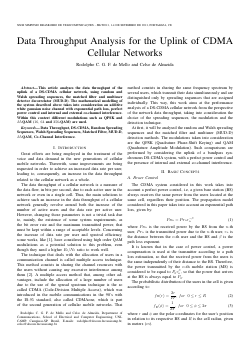
Data Throughput Analysis for the Uplink of CDMA Cellular Networks
Rodolpho C. G. F. de Mello, Celso de Almeida
DOI: 10.14209/sbrt.2013.116
Keywords: Data Throughput DS-CDMA Random Spreading Sequences Walsh Spreading Sequences Matched Filter MUD-D M -QAM Co-Channel Interference.
Abstract
This article analyses the data throughput of the uplink of a DS-CDMA cellular network, using random and Walsh spreading sequences, the matched filter and multiuser detector decorrelator (MUD-D). The mathematical modelling of the system described above takes into consideration an additive white gaussian noise channel with exponential path loss, perfect power control and internal and external co-channel interference. Within this context different modulations such as QPSK and M -QAM (16, 64 and 256-QAM) are used.Download
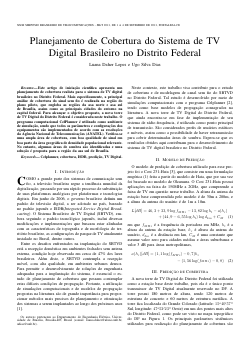
Planejamento de Cobertura do Sistema de TV Digital Brasileiro no Distrito Federal
Luana Daher Lopes, Ugo Silva Dias
DOI: 10.14209/sbrt.2013.113
Keywords: Celplanner cobertura ISDB predição TV Digital
Abstract
Este artigo de iniciação científica apresenta um planejamento de cobertura realista para o sistema de TV digital brasileiro no Distrito Federal. Mais especificamente, a principal análise de cobertura do sinal sem fio é realizada na região do plano piloto, que engloba as regiões da asa norte e asa sul de Brasília, assim como as principais cidades do entorno na capital federal. Para alcançar o objetivo proposto, a nova torre de TV Digital do Distrito Federal é considerada neste trabalho. O programa computacional CelPlanner é utilizado como ambiente de simulação, sendo que todos os parâmetros e configurações dos equipamentos são implementados de acordo com as resoluções da Agência Nacional de Telecomunicações (ANATEL). Verifica-se uma ampla área de cobertura, com boa qualidade de sinal em boa parte da área geográfica de densidade populacional relevante. No entanto, algumas áreas de sombra são identificadas e uma solução é proposta para a região da asa sul de Brasília.Download
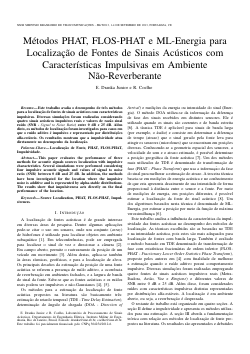
Métodos PHAT, FLOS-PHAT e ML-Energia para Localização de Fontes de Sinais Acústicos com Características Impulsivas em Ambiente Não-Reverberante.
E. Dranka Junior, R. Coelho
DOI: 10.14209/sbrt.2013.117
Keywords: Source Localization PHAT FLOS-PHAT Impulsiveness
Abstract
This paper evaluates the performance of three methods for acoustic signals sources localization with impulsive characteristics. Several simulations were performed considering four impulsive acoustic signals and values of signal to noise ratio (SNR) between 0 dB and 25 dB. In addition, the methods have been investigated for the location where the impulsive noise is additive and is represented by alpha-stable distributions. The results show that impulsiveness acts directly on the final performance of the location.Download
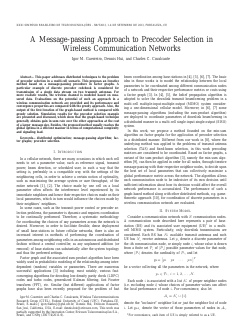
A Message-passing Approach to Precoder Selection in Wireless Communication Networks
Igor M. Guerreiro, Dennis Hui, Charles C. Cavalcante
DOI: 10.14209/sbrt.2013.243
Keywords: distributed optimization message-passing algorithm fac- tor graphs precoder selection
Abstract
This paper addresses distributed techniques to the problem of precoder selection in a multi-cell scenario. This proposes an iterative method based on a message-passing procedure in factor graphs. A particular example of discrete precoder codebook is considered for transmission of a single data stream on two transmit antennas. For more realistic results, the wireless channel is modeled based on mea- sured data. Evaluations on the potential of such an approach in a wireless communication network are provided and its performance and convergence properties are compared with the greedy approach. Also, the output of the first iteration of the graph-based method is compared with greedy solution. Simulation results for the precoder selection example are presented and discussed, which show that the graph-based technique generally obtains gain in sum rate over the other approaches at the cost of a larger message size. Besides, the proposed method usually reaches the global optima in a efficient manner in terms of computational complexity and signaling load.Download